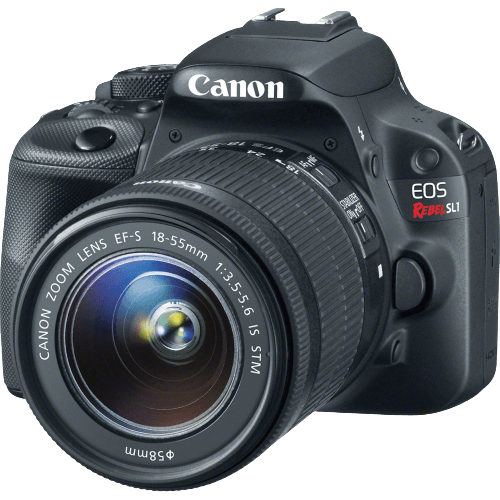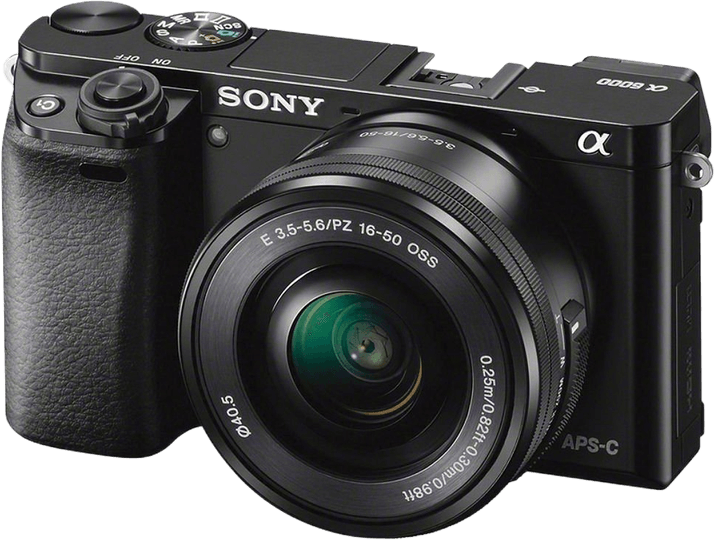Canon EOS Rebel SL1 / 100D vs Sony a6000 Comparison
Canon EOS Rebel SL1 / 100D

Sony a6000

The Sony a6000 emerges as the winner with a score of 57/100, outperforming the Canon EOS Rebel SL1 / 100D, which scored 43/100. Both cameras share similarities, such as being released in the early 2010s, with the Canon in 2013 and the Sony in 2014. They also have comparable launch prices; the Canon was priced at $650, while the Sony was slightly higher at $799.
The Sony a6000 excels with its mirrorless design, making it lighter at 344g compared to the Canon’s 407g. Additionally, its compact size (120 x 67 x 45mm) is advantageous compared to the Canon’s bulkier DSLR dimensions (117 x 91 x 69mm).
On the other hand, the Canon EOS Rebel SL1 / 100D has a lower launch price, making it a more budget-friendly option. However, the Sony a6000’s higher score reflects its superior performance and design, making it the better choice for those seeking a compact and lightweight camera.
Canon EOS Rebel SL1 / 100D vs Sony a6000 Overview and Optics
When comparing the optics of the Canon EOS Rebel SL1 / 100D and the Sony a6000, the Sony a6000 emerges as the winner with a score of 67 out of 100, while the Canon EOS Rebel SL1 / 100D scores 40 out of 100.
Both cameras share common specifications such as a CMOS sensor, APS-C sensor size, and the lack of image stabilization. However, the Sony a6000 outperforms the Canon EOS Rebel SL1 / 100D in several aspects. The Sony a6000 has a higher megapixel count at 24.3 compared to the Canon’s 18 megapixels, resulting in better image resolution. The a6000 also boasts a faster shooting speed of 11 frames per second, while the Canon has a shooting speed of 4 frames per second. Additionally, the Sony a6000 has a higher DXOMARK sensor score of 82, compared to the Canon’s score of 63, indicating better overall image quality.
On the other hand, the Canon EOS Rebel SL1 / 100D has its advantages as well. One notable feature is its Canon EF-S lens mount, which allows for compatibility with a wide range of Canon lenses. This could be beneficial for photographers who already own Canon lenses or prefer Canon’s lens selection.
In comparing the optics of these two cameras, it is clear that the Sony a6000 surpasses the Canon EOS Rebel SL1 / 100D in terms of image quality and speed. The higher megapixel count, faster shooting speed, and better DXOMARK sensor score make the Sony a6000 a superior choice for photographers seeking optimal image quality. However, the Canon EOS Rebel SL1 / 100D still holds its ground with a versatile lens mount, making it a viable option for those loyal to the Canon brand or with an existing collection of Canon lenses.
Canon EOS Rebel SL1 / 100D vs Sony a6000 Video Performance
The Sony a6000 outperforms the Canon EOS Rebel SL1 / 100D in video capabilities, scoring 56/100 compared to the Canon’s 43/100. Both cameras share some common specifications, such as having Full HD (1920 x 1080) maximum video resolution and lacking built-in time-lapse functionality.
The Sony a6000’s higher score is primarily due to its higher maximum video frame rate of 60fps, double that of the Canon EOS Rebel SL1 / 100D, which has a maximum frame rate of 30fps. This difference allows the Sony a6000 to capture smoother and more detailed video, especially in fast-paced scenes or when recording sports and action events.
On the other hand, the Canon EOS Rebel SL1 / 100D does not have any distinct advantages in video capabilities over the Sony a6000. Its lower maximum video frame rate of 30fps limits the camera’s ability to capture fast motion and results in less smooth footage compared to the Sony a6000.
Taking these factors into consideration, the Sony a6000 is the clear winner in terms of video capabilities. Its higher maximum video frame rate of 60fps provides smoother and more detailed footage, making it a better choice for those who prioritize video recording. The Canon EOS Rebel SL1 / 100D, with its lower video score and maximum frame rate of 30fps, is less suitable for capturing fast-moving subjects and may not meet the needs of users who require high-quality video performance.
Canon EOS Rebel SL1 / 100D vs Sony a6000 Features and Benefits
The Canon EOS Rebel SL1 / 100D wins in the feature comparison with a score of 57/100, while the Sony a6000 scores 41/100. Both cameras have a 3-inch screen, no GPS, and no Bluetooth. However, the Canon SL1 has a higher screen resolution of 1,040,000 dots compared to the Sony a6000’s 921,600 dots. The Canon SL1 also has a touchscreen, making it easier to navigate through settings and control the camera.
The Sony a6000 has two advantages over the Canon SL1: a flip screen and built-in Wi-Fi. The flip screen allows for more creative angles while shooting and is especially useful for vlogging or taking selfies. The built-in Wi-Fi makes it convenient to transfer photos and videos to a smartphone or computer wirelessly.
Despite these advantages, the Canon SL1’s higher feature score shows that it offers more in terms of overall functionality. The higher screen resolution and touchscreen make it easier to use and provide a better user experience.
On the other hand, the Sony a6000’s flip screen and Wi-Fi capabilities are beneficial for those who prioritize flexibility in shooting angles and ease of sharing content. However, these features alone may not be enough to outweigh the benefits provided by the Canon SL1.
In comparing the Canon EOS Rebel SL1 / 100D and the Sony a6000, the Canon SL1 comes out on top due to its higher feature score, better screen resolution, and touchscreen functionality. The Sony a6000 has its advantages, but they may not be enough to surpass the Canon SL1’s overall stronger feature set.
Canon EOS Rebel SL1 / 100D vs Sony a6000 Storage and Battery
Both the Canon EOS Rebel SL1 / 100D and the Sony a6000 receive a storage and battery score of 21/100, indicating equal performance in this aspect. Each camera has one memory card slot and accepts SD, SDHC, and SDXC cards. However, the Sony a6000 also supports Memory Stick Pro Duo and Pro-HG Duo cards, giving it an advantage in terms of storage versatility.
The Canon EOS Rebel SL1 / 100D has a slight edge in battery life, providing 380 shots per charge compared to the Sony a6000’s 360 shots. Both cameras use different battery types, with the Canon using an LP-E12 battery and the Sony using an NP-FW50 battery. Neither camera supports USB charging.
Despite their equal scores, the Canon EOS Rebel SL1 / 100D offers slightly better battery life, while the Sony a6000 provides more storage compatibility options. The choice between these two cameras depends on the user’s priorities regarding storage and battery performance.
Canon EOS Rebel SL1 / 100D vs Sony a6000 Alternatives
Still not sure which camera is best for you? Check out some more popular camera comparisons for inspiration:
